 |
 |
 |
| |
Virco: Population and clonal tropism phenotyping of clinical isolates and comparison with next generation sequencing and prediction tools
|
| |
| |
Reported by Jules Levin
18th Intl HIV Drug Resistance Workhop
June 9-12 2009, Ft Myers FL
K Van Baelen1, E Rondelez1, L Van Wesenbeeck1, W Mostmans1, H Van Marck1, V Van Eygen1, C Verhofstede· , L Vandekerckhove·, I Vandenbroucke1 and L Stuyver1 and the Tropism Work Group·
1Virco, Mechelen, Belgium; ·Aids Reference Laboratory, Ghent University Hospital, Belgium; *The Tropism Working Group consists of Katrien Fransen·, Dolores Vaira4, Kabamba Kabeya5, Stephane De Wit5, Eric Florence· and Michel Moutschen4 (·Institute of Tropical Medicine, Antwerp, Belgium, 4CHU Sart Tilman, Liège, Belgium, 5Centre Hospitalier Universitaire Saint-Pierre, Brussels, Belgium)
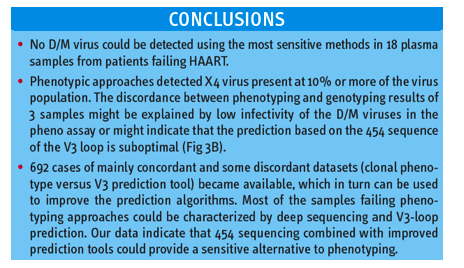
BACKGROUND
The use of CCR5 antagonists is currently limited to patients with R5-tropic HIV only. Several assays to measure tropism of clinical samples, and algorithms to predict tropism have been developed. In this report, we use the clonal and population Virco tropism assay, a phenotypic prediction tool based on 454 sequences and the standard Trofile assay to analyze 44 clinical isolates from patients failing HAART therapy.
METHODS
Plasma from 44 treatment-experienced patients with standard Trofile (Monogram) assay results was available. The workflow is given in Figure 1.
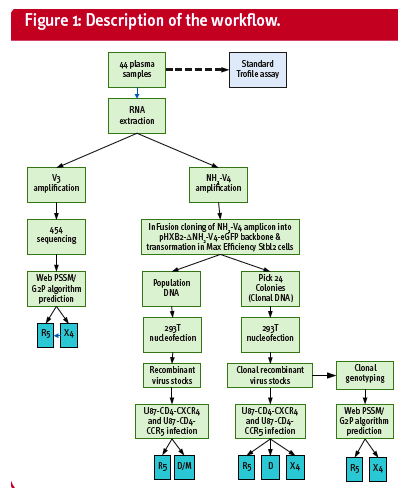
All samples were tested in the Virco phenotypic tropism assay, using population and clonal approaches. In short, RNA was extracted and the gp120 NH2-V4 region (1430 bp on HXB2) was amplified in a one-step RT-PCR reaction. The purified NH2-V4 amplicons were recombined with a HIV-1 backbone, deleted for NH2-V4. Recombinant plasmids were transfected into 293T cells. The generated virus stocks were used for infection of U87-CD4-CXCR4 and U87-CD4-CCR5 cells. Infection was evaluated by fluorescence read out. In addition to this population-based assay, 24 clones per patient were picked and the same procedure was followed to determine clonal tropism (for a detailed description see Van Baelen et al 2007). The NH2-V4 region of the clonal recombinant viruses was sequenced. Phylogenetic analyses were conducted in MEGA4.
In parallel, the V3-loop of the clinical samples was amplified using barcoded primers, amplicons were equimolar pooled, and sequenced on the 454 GS-FLX instrument. Tropism was predicted using the WebPSSM and G2P algorithm.
RESULTS
Population phenotype results were obtained for · 56.8% (n=25) and 84.1% (n=37) of samples in the Trofile and Virco tropism pheno assay, respectively (Table 1). Nineteen samples displayed concordant results between the two assays. However, two discordant results between the two assays were found (R5 by the Trofile assay and D/M by the Virco assay). The D/M results were confirmed by the clonal analysis.
Using Trofile as a reference, the Virco population based tropism pheno assay showed for D/M:
- Sensitivity: 100%;
- Specificity: 89%;
- Positive Predictive Value (PPV): 60%;
- Negative Predictive Value (NPV): 100%.

Clonal phenotyping was successful on 37 samples, resulting in 936 plasmids of which 692 (73.9%) yielded infectious virus with the following distribution: R5=613, D=57, and X4=22 clones (Table 2). 72% clones per sample were infectious.
Clonal genotyping was successful on 36 samples. Phylogenetic analysis revealed that there is high variation in the NH2-V4 sequence of the different clones within one sample (Figure 2A, representative example). It also demonstrated that the dual viruses are clustered together (Figure 2B, representative example).
454 V3-loop sequencing generated an average of 13475 reads/sample. The % of predicted X4 virus was calculated and compared to phenotyping results (Table 2 and Figure 3):
0% predicted X4 (n=18) showed up as R5 in popu¬lation- and clonal-based phenotyping;
0.07% to 10% predicted X4 (n=10) showed up as R5 in population-, but an occasional D in clonal phenotyping;
>10% predicted X4 (n=14) showed up as R5/D/X4 in clonal phenotyping, increasing propensity for D/M in population phenotyping;
> 99% predicted X4 (n=6) showed up as pheno¬typically R5 (n=3) or D/M (n=3).

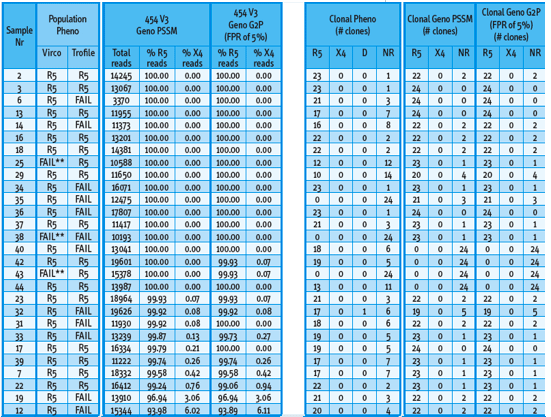
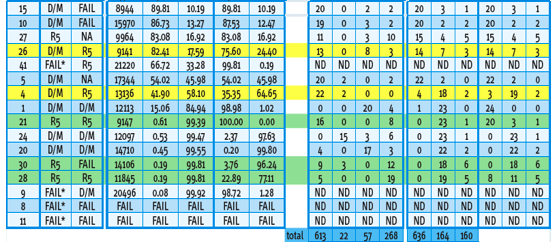
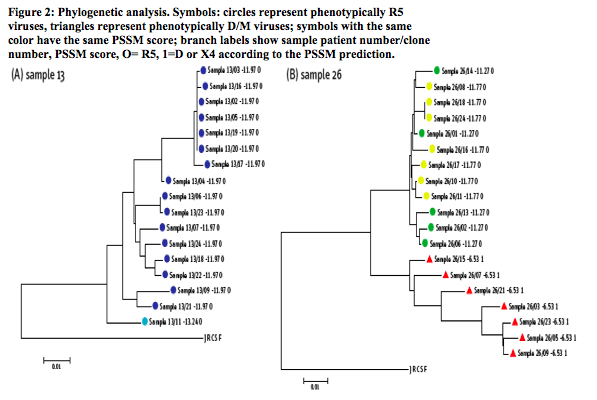
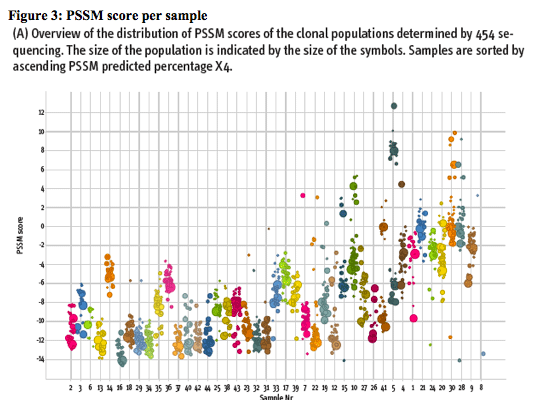

|
| |
|
 |
 |
|
|